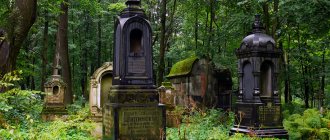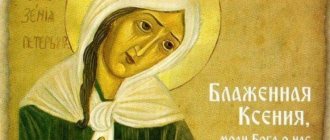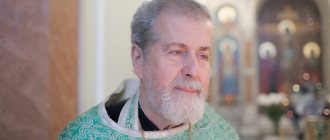Saint Xenia of Petersburg is revered by a huge number of people.
Being of sound mind, Ksenia accepted the role of the holy fool (the city madwoman), for the sake of love for her late husband. Since then, the love of Blessed Xenia, even after her death, has extended to all those in need. The woman’s action, at first glance, really seems inadequate. However, without touching on religious views, we will try to understand what led Ksenia to the decision to take the path of foolishness and how she deserved people’s love.
Ksenia Petersburgskaya: life before the tragedy
Not much information has been preserved about Ksenia’s life before she became a city madwoman. It is known that she was born in St. Petersburg in 1719-1730, and her father’s name was Gregory.
Some conclusions can be drawn from subsequent facts of her life. At the age of 23, Ksenia was given in marriage to Colonel Andrei Fedorovich Petrov, who, moreover, sang in the church choir at the court of Empress Elizabeth. The young man was very respectable; the court singers under the cheerful empress had dizzying careers.
One has only to remember Count Razumovsky, who from the Dnieper swineherds quickly rose to high society and became the favorite of the mother of the Russian state.
Considering that during marriages in those days class boundaries were strictly observed, one can assume that Ksenia herself was of noble origin. Most likely, the girl was not only religious, but also quite well educated.
The couple settled on the 11th line (present-day Lakhtinskaya Street), on which land plots were distributed for military personnel of the Kaporsky Regiment.
Ksenia lived well with Andrei Fedorovich. The love and harmony in the young family sometimes aroused the envy of the neighbors.
Quiet happiness does not arouse much interest among ordinary people, and therefore the people’s memory has preserved nothing more about that life of Ksenia.
“I was involved in restoration from a young age”
– Nikolai Vladimirovich, can you tell us a little about yourself?
– I was born in St. Petersburg, but my roots are from Vologda, my parents came from Cherepovets. And by the way, I can tell a story related to Providence. Perhaps, thanks to my grandmother, our family did not die of hunger. She was a very religious person, and before the war she had a vision of a railway, a steam locomotive, and hot-vehicle trains. And an old man in black clothes looks out from the last carriage, raises his finger and says: “Anna, sushi crackers.” The train left, and the grandmother began to dry the crackers, thanks to which they lived throughout the war. I was born after her death.
– How did you come to your current line of work?
“I was involved in restoration from a young age. Once, in the 70s, they told me that since I was working with icons, it would be good to be baptized. We came to the bank of the Velikaya River in Pskov, two girls were singing, well, there was like a choir, the priest dipped me into the river three times. That's how I became baptized.
One day, an acquaintance of mine who lived in those parts said that there was such a wonderful church, a man came to the rector of which, suggesting: “Father, let’s remove this dilapidated iconostasis, old carvings. I have good paper - shiny. We'll cover everything with it. Here are some samples for you. Everything will shine wonderfully for you.” They called me and I said: “Well done for not doing this, for preserving the old days. Restoration is needed here." After which he settled in the church gatehouse and began to work. It was in an interesting place - Terebeni, where Kutuzov’s parents are buried. The rector of this poor parish was Father Eleutherius (Popov), a resident of the Pechora Monastery. He wasn’t very talkative, I never even heard the pronoun “I” from him: “I went”, “I did” - he didn’t say that.
I have been involved in restoration all my life, that is, for quite a long time, after all, I am 67 years old. He worked with monumental painting, taught, but most importantly - restoration.
There are many stories connected with this. Bitter memories remain of the restoration in the Church of St. Catherine. After the war, captured German literature was stored there, but there was a fire. The religious painting was damaged very seriously - it literally boiled with bubbles that burst. Some of the paint was peeling off. However, all this was subject to restoration. In addition to paintings, the best organ in St. Petersburg, entirely made of wood, has been preserved there. Even the pipes were not metal, but wooden. We worked for a long time, and when we more or less secured everything, a new fire happened - on the day of Andropov’s funeral - which burned everything out irrevocably.
While working at St. Catherine's Church
The work at the Sampson Church in St. Petersburg was very interesting, where I had to restore the February month book. This is an icon with many, many small images - miniatures of saints for every day. How difficult was this work? Previous restorers displaced the fragments, the paint layer began to lift and partially crumbled. Unfortunately, restorations often bring a lot of problems, although often I just admire what the predecessors did.
Turning point: the sudden death of her husband
People's attention is attracted by sensations, whether it is a tragedy or a triumph.
Ksenia’s life changed overnight: after 3 years of marriage, her beloved husband suddenly died, not having time to accept his final repentance and absolution.
It is believed that Andrei Fedorovich was killed by typhus. However, it was rumored that the young man was killed by wine, like many artists at the royal court.
At the time of her husband’s death, Ksenia was 26 years old; the couple did not have time to have children.
The sudden death of her husband shocked the young woman; relatives and neighbors feared for her sanity. And there were serious reasons for these fears.
For the funeral, Ksenia wore her husband’s red-green military uniform. The woman stated that she was “Andrei Fedorovich”, and Ksenia died. Everyone experiences the death of a loved one in their own way, but Ksenia’s “quirks” did not stop. The woman decided to give her house to her friend Praskovya Antonova, who rented a room in their house, with the only condition: the new owner had to let those in need stay overnight.
Relatives, fearing such an unwise squandering of their acquired wealth, invited a commission of former bosses of the late Petrov to confirm Ksenia’s madness and admit her to a hospital. However, after a long conversation, the higher ranks considered the woman quite adequate.
Ksenia Petersburgskaya. Artist Alexander Prostev
conclusions
There are protocols for processing materials and painting techniques, which were compiled by employees of the museum’s research department. Then an art historical analysis was carried out. After all stages of the study, the artists and restorers concluded that the portrait had been very carefully preserved. It also became known that the lifetime portrait of Xenia of Petersburg was painted spontaneously. Perhaps even in one go. The artist drew the facial features in detail.
Thus, it becomes clear that this portrait is not a fantasy at all. The likelihood that Ksenia Grigorievna is looking at us from the canvas is very high.
The time has come for people to see the lifetime portrait of the blessed one. Ksenia of Petersburg. The canvas depicts the image of a man from whom the myth of the city on the Neva was born. This amazing transformation happened to Ksenia Grigorievna in life, thanks to which her portrait also became an icon. The death of her husband was a huge blow for her, turning her whole mind upside down.
City madwoman - or saint?
With the death of her husband, a new stage of 45 years began in Ksenia’s life. Dressed in men's clothing and responding only to “Andrei Petrovich,” Ksenia wandered the streets. The poor woman was offended by homeless children, she was driven even from her own parish, the Church of the Apostle Matthew (Church of the Intercession), so as not to spoil the view when foreigners arrived. People mistook the blessed woman’s inarticulate muttering for nonsense.
But, despite the mistreatment, Ksenia never showed anger or resentment, humbly accepting the fate she had chosen.
Someone took pity on the holy fool, offering her clothes and shoes. Ksenia's frostbitten legs were swollen, but she refused to change her rags. Some gave her money. Blessed Xenia accepted only copper coins with the image of St. George the Victorious - and even then not from everyone.
Ksenia Petersburgskaya. Artist Alexander Prostev
Sometimes, refusing, she said: “I won’t take your money, you offend people.”
But the poor woman immediately distributed the small change given to her to other sufferers.
Gradually people got used to the city madwoman, and began to notice that Ksenia brings grace. Those from whom she accepted change suddenly experienced joy. Sellers from the well-fed market began to treat her, and cab drivers began to give her lifts so that her work that day would bring her good income.
Ksenia has become a kind of talisman of good luck.
However, another sign also arose: if the blessed one asked for something, that person would soon experience grief. The holy fool predicted the death of the empress, shouting the day before: “Bake pancakes. Soon all of Russia will be baking pancakes.” Elizabeth soon died.
Ksenia Petersburgskaya.
Artist Alexander Prostev By the way, the tradition of baking pancakes was associated with Maslenitsa and funerals.
A similar prophecy concerns the person of John VI. After the blessed woman’s long sobs and lamentations of “blood, rivers of blood,” Petersburg learned of the murder of Ivan Antonovich.
And in Russia, emperors, as a rule, were killed stupidly, cruelly and bloodily.
Poor Ksenia not only warned people about upcoming joy or sorrow. The woman helped with any everyday disaster, but only to kind and decent people. So, she sent Praskovya Antonova to the cemetery, where a woman hit by a crew gave birth to a baby and died, and childless Praskovya found a son. Another time, Ksenia, by giving a copper to a lady, helped her avoid the complete destruction of the house in a fire.
Sick Ksenia.
Artist Alexander Prostev Only once did she get angry at the children mocking her. However, this moment only reminds us that a grief-stricken woman is the same person, and just as susceptible to sin.
The list of wonders of Ksenia is huge.
Whether this is a coincidence or God's providence is not for us to decide. The main thing is that blessed Ksenia, hanging around the Smolensk cemetery (the burial place of her husband), became a local celebrity. Children were brought to her for a blessing and asked for advice in everyday affairs and marriage.
The police became interested in the city beggar and tracked where the homeless woman was hiding at night. Law enforcement officers found out that the crazy woman was leaving the city and praying in the field all night, despite the bad weather.
Another incredible incident from the life of Blessed Ksenia. Construction of the Trinity Cathedral has just begun at the Smolensk cemetery. Workers had to struggle to lift stones up the scaffolding. Every morning they discovered that someone had lifted the stones up for them overnight.
After sitting on guard at night, they saw how the local beggar Ksenia was carrying a heavy shoulder stretcher - and carefully stacking bricks in piles. At that time the woman was over 60 years old.
The fate of the portrait a century earlier
Throughout the 19th century, the lifetime portrait of Xenia of Petersburg from the Hermitage was in the chapel at the Smolensk cemetery. There was a lamp in front of him, or maybe a candle, so a layer of soot formed on the image. The canvas was very dark. Museum workers learned that the portrait had gone through several unprofessional restorations.
Thus, it was extremely difficult to restore the original appearance of the image. Before professional restoration, the portrait was quite dark, and the blessed woman’s robe was baggy. There was some gray in my hair here and there. During the work, the artists corrected the shape of the shoulders. Thanks to this, the portrait became more interesting and looked complete.
Previously, no one could have imagined what Ksenia of Petersburg looked like. It became possible to see the face of the saint thanks to the work of restorers. They gave the canvas varnish and perfect toning. Today it is impossible for anyone to find out in more detail about the process of creating a portrait.
Xenia and the Church: a long path to holiness
Ksenia Petersburgskaya died at the age of 71 at her husband’s grave. Half the city accompanied her from the Church of the Intercession to the Smolensk cemetery. For dozens of years, the soil from her grave, and even gravestones, were taken away by pilgrims who believed in their miraculous power. In 1830, a chapel was built over her grave, to which many believers still flock.
Ksenia Petersburgskaya.
Artist Alexander Prostev The marble tombstone over the grave was built with the money of pilgrims.
People's love saved the blessed one's last refuge from destruction by the Bolsheviks. However, during the war, an armory was built at the holy place, and in the 60s. the chapel was given over to a sculpture workshop.
Only in 1978 did the church recognize the holiness of Blessed Xenia. Dozens of churches in Russia, Belarus, Ukraine, Estonia, Kazakhstan and Bulgaria are named after her. You can hear thousands of stories of how Ksenia’s prayer healed, gave the joy of motherhood, and saved in difficult situations.
There is not a single thing left that belonged to Xenia, and there are no lifetime portraits of the saint (perhaps there is one portrait of Xenia, recently found in the Hermitage archives - but this statement has no evidence yet).
In the personal house-museum, paintings by Alexander Prostev are exhibited - however, this is only the artist’s subjective judgment about the appearance of the saint.
Ksenia Petersburgskaya.
Artist Alexander Prostev On the icons, Xenia of Petersburg is always depicted in green and red clothes; the blessed one remained faithful to the colors of her military uniform all her life.
There are also documentaries about Xenia of St. Petersburg - however, most of them examine Xenia from a religious point of view.
The image of the St. Petersburg blessed one became the reason for the creation of a play at the Alexandrinsky Theater. This is a unique case of transferring the life of a saint to the theater stage. At the same time, the emphasis is not on the miracles performed by Ksenia, but on the theme of love : from a collision with a cruel world, Ksenia managed to endure and increase love to an all-encompassing breadth.
Research
The Hermitage workers had to work hard. Restorers conducted laboratory tests, during which it was revealed that this was a real relic. Technical and technological expertise carried out a soil analysis, which showed that the canvas was made at the end of the 18th or beginning of the 19th century. Studies of the frame design confirmed the findings of the chemical analysis. The portrait is a work of art from the era in which the saint lived. The lifetime portrait of Ksenia of St. Petersburg contains the image of a man of God who carries out a Christian feat.











